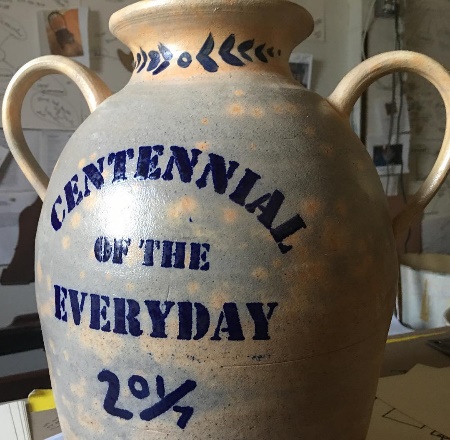
The City of Alexandria’s Office of the Arts partners with Baltimore-based artists Stewart Watson and Lauren Frances Adams for a series of site-specific, all-media installations inspired by the history of Gadsby’s Tavern Museum. Centennial of the Everyday features artistic interventions tucked in among the historic exhibits. It will be on view May 15 – September 3, 2017, at the Museum, located at 134 North Royal Street.
The works reflects the artists’ in-depth research—documented via social media—on the history of women, enslaved people, and anonymous citizens whose stories are overshadowed by other more famous historic figures from the region, such as George Washington and Robert E. Lee.
In Centennial of the Everyday, historic ephemera takes on new contexts. With furniture, stoneware, and textiles as a starting point, Watson and Adams reflect domestic material culture of the past with modern techniques.
For example, in the room of the Female Stranger—an unidentified woman who died in Gadsby’s City Tavern in 1816—the pair created digitally designed muslin bedding with a traditional cameo motif that seems to fall away as the pattern continues
In the Museum’s Ballroom, the artists acknowledge the original Gadsby’s Ballroom, acquired 100 years ago, 1917, by the Metropolitan Museum of Art in New York. The woodwork now serves as a backdrop for the Met’s collection of Federalist furnishings in the American Wing.
Watson and Adams seek to turn the archival into the interactive. They identified personal stories of place and family history by interviewing people like the descendants of John Gadsby, as well as Nancy Syphax, an enslaved woman owned by Gadsby in the 19th century. Also included was a Gadsby’s Tavern Restaurant employee who has worked at the restaurant for two decades. In all, they collaborated with seven subjects, focusing on women and people of color. With these narratives, the pair created a fantastical sculptural installation for the Ballroom. Using period chairs and altered furniture, these sculptures examine the extraordinary within the conventional.
The duo’s artistic interventions are positioned throughout Gadsby’s Tavern Museum. Each highlight points from the Museum’s history and public-record archives and parallel the lived stories of present-day Alexandrians and the region’s rich diversity. Architectural fixtures, portraiture of anonymous women, pattern books, and newspaper articles take on new meaning when framed with themes of anonymity, loss, connectivity, and the fragility of memory.
“We hope our project encourages visitors to see history and identity in a new light,” said Watson. “These sculptures and site-specific works evoke the fragility and personal nature of memory.”
“We are thrilled to present our site-responsive work at Gadsby’s Tavern Museum,” said Adams. “Our work foregrounds the underappreciated narratives of many peoples from Alexandria’s rich history.”
This project is part of the Office of the Arts’ Time & Place series, which explores the intersection of contemporary art with Alexandria’s rich and multifaceted history. Using research-based practices and working in a variety of media, Stewart Watson and Lauren Frances Adams—along with Washington-based performance artist Sheldon Scott—have created thought-provoking temporary works that are inspired by the storied past of Gadsby’s Tavern.
“Time and Place shines new light on familiar stories and uses the arts to draws connections between past and present,” said Diane Ruggiero, director of the Alexandria Office of the Arts and Events.